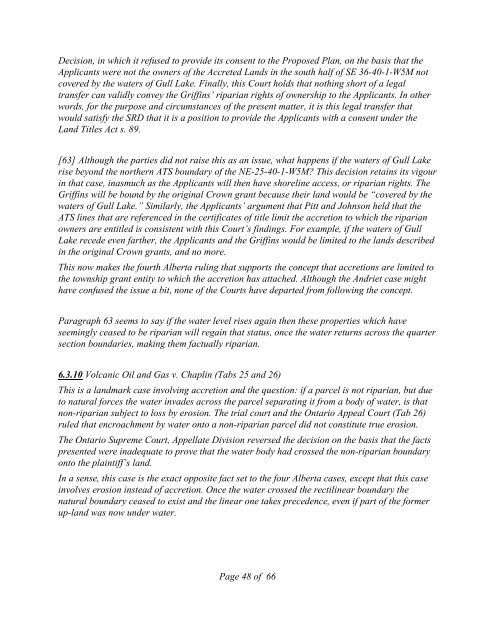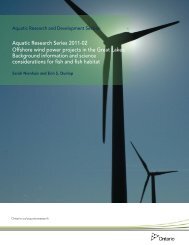Report of Research, Field Investigation and Survey of Robert D ...
Report of Research, Field Investigation and Survey of Robert D ...
Report of Research, Field Investigation and Survey of Robert D ...
You also want an ePaper? Increase the reach of your titles
YUMPU automatically turns print PDFs into web optimized ePapers that Google loves.
Decision, in which it refused to provide its consent to the Proposed Plan, on the basis that the<br />
Applicants were not the owners <strong>of</strong> the Accreted L<strong>and</strong>s in the south half <strong>of</strong> SE 36-40-1-W5M not<br />
covered by the waters <strong>of</strong> Gull Lake. Finally, this Court holds that nothing short <strong>of</strong> a legal<br />
transfer can validly convey the Griffins’ riparian rights <strong>of</strong> ownership to the Applicants. In other<br />
words, for the purpose <strong>and</strong> circumstances <strong>of</strong> the present matter, it is this legal transfer that<br />
would satisfy the SRD that it is a position to provide the Applicants with a consent under the<br />
L<strong>and</strong> Titles Act s. 89.<br />
[63] Although the parties did not raise this as an issue, what happens if the waters <strong>of</strong> Gull Lake<br />
rise beyond the northern ATS boundary <strong>of</strong> the NE-25-40-1-W5M? This decision retains its vigour<br />
in that case, inasmuch as the Applicants will then have shoreline access, or riparian rights. The<br />
Griffins will be bound by the original Crown grant because their l<strong>and</strong> would be “covered by the<br />
waters <strong>of</strong> Gull Lake.” Similarly, the Applicants’ argument that Pitt <strong>and</strong> Johnson held that the<br />
ATS lines that are referenced in the certificates <strong>of</strong> title limit the accretion to which the riparian<br />
owners are entitled is consistent with this Court’s findings. For example, if the waters <strong>of</strong> Gull<br />
Lake recede even farther, the Applicants <strong>and</strong> the Griffins would be limited to the l<strong>and</strong>s described<br />
in the original Crown grants, <strong>and</strong> no more.<br />
This now makes the fourth Alberta ruling that supports the concept that accretions are limited to<br />
the township grant entity to which the accretion has attached. Although the Andriet case might<br />
have confused the issue a bit, none <strong>of</strong> the Courts have departed from following the concept.<br />
Paragraph 63 seems to say if the water level rises again then these properties which have<br />
seemingly ceased to be riparian will regain that status, once the water returns across the quarter<br />
section boundaries, making them factually riparian.<br />
6.3.10 Volcanic Oil <strong>and</strong> Gas v. Chaplin (Tabs 25 <strong>and</strong> 26)<br />
This is a l<strong>and</strong>mark case involving accretion <strong>and</strong> the question: if a parcel is not riparian, but due<br />
to natural forces the water invades across the parcel separating it from a body <strong>of</strong> water, is that<br />
non-riparian subject to loss by erosion. The trial court <strong>and</strong> the Ontario Appeal Court (Tab 26)<br />
ruled that encroachment by water onto a non-riparian parcel did not constitute true erosion.<br />
The Ontario Supreme Court, Appellate Division reversed the decision on the basis that the facts<br />
presented were inadequate to prove that the water body had crossed the non-riparian boundary<br />
onto the plaintiff’s l<strong>and</strong>.<br />
In a sense, this case is the exact opposite fact set to the four Alberta cases, except that this case<br />
involves erosion instead <strong>of</strong> accretion. Once the water crossed the rectilinear boundary the<br />
natural boundary ceased to exist <strong>and</strong> the linear one takes precedence, even if part <strong>of</strong> the former<br />
up-l<strong>and</strong> was now under water.<br />
Page 48 <strong>of</strong> 66
















